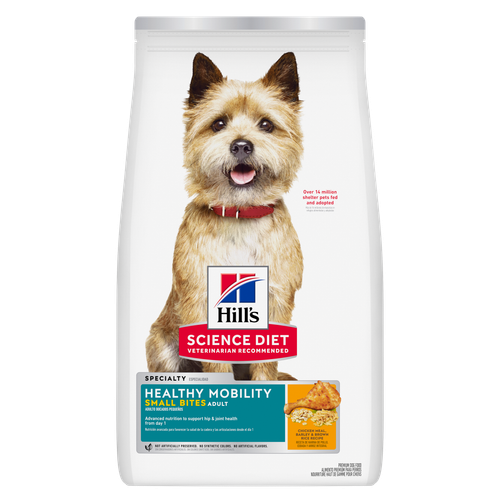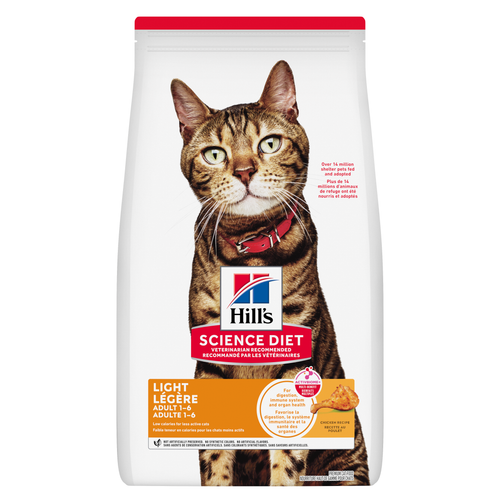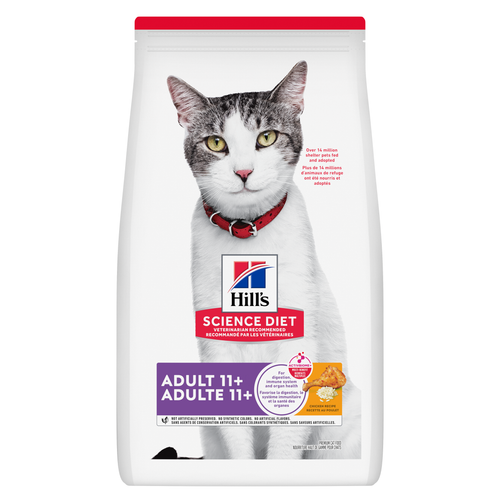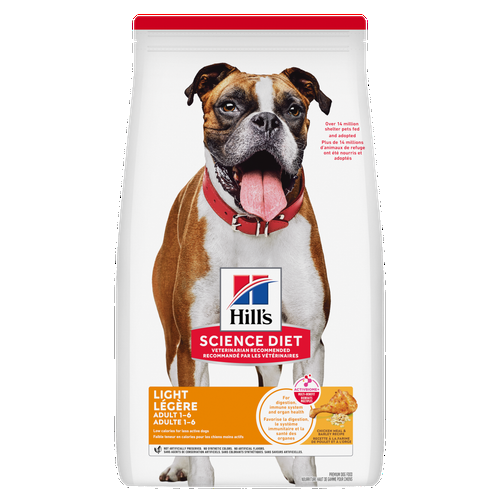
-
Find the right food for your petTake this quiz to see which food may be the best for your furry friend.Find the right food for your petTake this quiz to see which food may be the best for your furry friend.Featured products
 Adult Healthy Mobility Small Bites Chicken Meal, Barley & Brown Rice Recipe Dog Food
Adult Healthy Mobility Small Bites Chicken Meal, Barley & Brown Rice Recipe Dog FoodAdvanced nutrition to support hip & joint health from day 1
Shop Now Adult Sensitive Stomach & Skin Small & Mini Chicken Recipe Dog Food
Adult Sensitive Stomach & Skin Small & Mini Chicken Recipe Dog FoodHill's Science Diet Sensitive Stomach & Skin Small & Mini dry dog food is tailored nutrition for Small & Mini dogs while being gentle on stomachs. Nourishes skin & promotes a lustrous coat.
Shop Now Adult Light Large Breed Chicken Meal & Barley Recipe Dog Food
Adult Light Large Breed Chicken Meal & Barley Recipe Dog Food18% lower calories vs. Science Diet Large Breed Adult
Shop NowFeatured products Adult Healthy Cuisine Seared Tuna & Carrot Medley Cat Food
Adult Healthy Cuisine Seared Tuna & Carrot Medley Cat FoodDelicious seared tuna paired with tender carrots in a mouthwatering sauce
Shop Now Adult Light Chicken Recipe Cat Food
Adult Light Chicken Recipe Cat Food20% lower calories vs. Hill's Science Diet Adult
Shop Now Adult 11+ Chicken Recipe Cat Food
Adult 11+ Chicken Recipe Cat FoodSupports brain health & beautiful fur. Helps keep immune system, heart & kidneys healthy.
Shop Now -
Dog
- Dog Tips & Articles
-
Health Category
- Weight
- Food & Environmental Sensitivities
- Urinary
- Digestive
- Joint
- Kidney
- Dental
- Cancer
-
Life Stage
- Puppy Nutrition
- Adult Nutrition
- Senior Nutrition
Cat- Cat Tips & Articles
-
Health Category
- Weight
- Skin & Food Sensitivities
- Urinary
- Digestive
- Kidney
- Dental
- Stress
- Cancer
-
Life Stage
- Kitten Nutrition
- Adult Nutrition
Featured articles Importance of DHA in your Pet's Food
Importance of DHA in your Pet's FoodLearn about DHA, Docosahexaenoic Acid, a natural omega-3 fatty acid that is essential in the development of the brain and nervous system in cats & dogs.
Read More Water
WaterDiscover why water is the most important nutrient for your dog or cat to live a healthy life. Find out how much water your pet should consume each day.
Read More Antioxidants
AntioxidantsUnderstand the importance of antioxidants in your dog or cat's food, and how they can help protect your pet and keep them healthy.
Read More -


Do you have a dog whose nose turns pink as the weather outside gets colder? If so, your dog might have what is commonly referred to as snow nose. But cold weather isn't the only reason some dogs' noses turn pale. Want to know why dogs' noses turn pink, and whether it is something you should worry about? Here's what you need to know.
What Is Snow Nose?

Snow nose is a common term for a dog nose that's loses pigment and turns from black/brown to pink. Typically, this either appears as spots or as a stripe down the center of the nose, says Life In the Dog Lane.
Dogs are more likely to get snow nose during the winter or in cold climates. However, snow nose isn't limited to dogs in northern climates, as was once believed. It's usually temporary, with pigment returning to normal once the weather warms up. But as dogs get older, their snow noses sometimes stick around all year.
While snow nose doesn't seem to be restricted to certain types of dogs, some breeds are more likely to get it than others. Snow nose most commonly occurs among Siberian huskies, Labrador retrievers, golden retrievers and Bernese mountain dogs — all breeds that are originally from northern climates.
Why Do Dogs' Noses Turn Pink?
No one knows for sure what causes snow nose. One possible explanation is that it's caused by the breakdown of tyrosinase, the enzyme that produces melanin, or skin pigment, says Cuteness. Tyrosinase is sensitive to cold temperatures and also tends to break down with age. This fails to explain, however, why snow nose only occurs in some dogs and why it can also affect dogs in warmer climates. The answers to these questions remain a mystery.


Tasty Tips
Should You Worry If Your Dog Gets Snow Nose?
Snow nose doesn't need to be treated by a doctor any more than gray hair in humans needs to be. And there's no way to restore lost pigment to your dog's nose. That said, melanin helps protect your dog's tender nose from sun damage. Without this natural protection, you'll need to limit your dog's sun exposure or apply a dog-friendly sunscreen to their nose before they go into the sun.
And while the exact cause of snow nose is unknown, some veterinarians recommend having your dog's thyroid checked out in order to rule out a thyroid issue as a possible cause, says The Spruce Pets. Some vets also believe that loss of pigment could be a reaction to chemicals leaching from plastic food or water dishes. To be on the safe side, switch your dog's bowls to metal or ceramic if they aren't already. And it's always a good idea to report any sudden changes in the appearance of your dog's nose to your vet.
Snow nose is a fairly common occurrence and usually not cause for concern. Once any health issues are ruled out, you can rest easy knowing there's nothing wrong with your pet — even if their newly pink nose might take some getting used to.


Jean Marie Bauhaus is a pet parent, pet blogger, and novelist from Tulsa, Oklahoma, where she usually writes under the supervision of a lapful of fur babies.
Related products

Advanced nutrition to support hip & joint health from day 1

Hill's Science Diet Sensitive Stomach & Skin Small & Mini dry dog food is tailored nutrition for Small & Mini dogs while being gentle on stomachs. Nourishes skin & promotes a lustrous coat.

18% lower calories vs. Science Diet Large Breed Adult

18% lower calories vs. Science Diet Adult
Related articles

Learn basic steps & precautions for treating a cut on your dog, including what you can put on the cut, and when you should take them to the vet.

Discover how the field of dog science is giving us more and more insights into the inner workings of our furry best friends.

Learn how dogs with sensitive skin can have special dietary needs, how they can develop over time in a healthy dog, and how Hill's dog food can help.

Your dog's coat and skin are a big part of your dog's overall health. Ensure you keep your dog's coat healthy, by following these simple tips.

Put your dog on a diet without them knowing
Our low calorie formula helps you control your dog's weight. It's packed with high-quality protein for building lean muscles, and made with purposeful ingredients for a flavorful, nutritious meal. Clinically proven antioxidants, Vitamin C+E, help promote a healthy immune system.
Put your dog on a diet without them knowing
Our low calorie formula helps you control your dog's weight. It's packed with high-quality protein for building lean muscles, and made with purposeful ingredients for a flavorful, nutritious meal. Clinically proven antioxidants, Vitamin C+E, help promote a healthy immune system.

